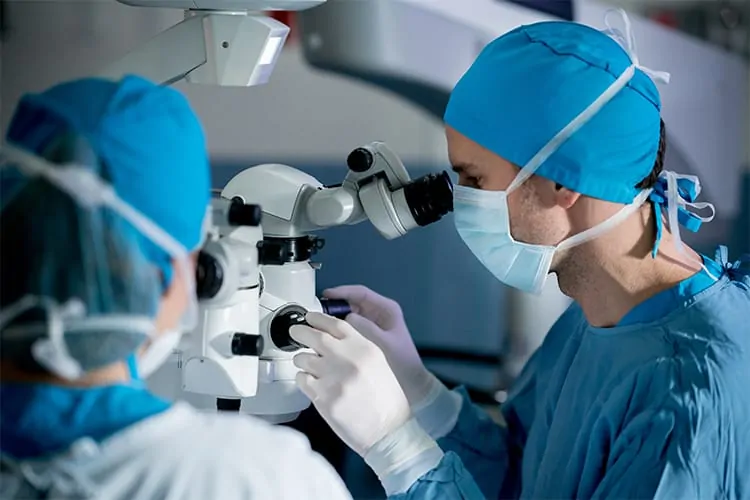What are the best option if you have had your tubes tied but now want to become pregnant? Read about the pros and cons of surgery versus IVF, how sterilisation can be surgically reversed, and the possible benefits of IVF treatment.
If you have had your tubes tied, but for some reason your situation has changed, you still have options either having the sterilisation surgically reversed or having IVF treatment. To help you decide on the best option for you, it would be useful to have a discussion with a reproductive surgeon who has expertise with both IVF and surgical reversal as the decision involves assessing many factors for both you and your partner. Some couples could equally benefit from the surgical option or IVF while for other couples, one of these options would be more suitable than the other. In both cases, you will usually need to self-fund your treatment.
What factors need to be considered to help me decide?
Your doctor will conduct a full fertility assessment for you and your partner to see if there are any other factors that may affect fertility. For example, if your partner’s sperm test shows some problems such as low sperm count, then the surgical option would not be suitable. Similarly, in women who are older, the success rates of IVF would often be lower and in that case surgery would be the better option. In summary, to have surgery the doctor would need to ensure that there are no other factors that would hinder your chances of getting pregnant after the surgery.
What are the pros and cons of Surgery vs IVF
If you are eligible for both surgery and IVF then it is useful to consider the relevant advantages of both approaches to help you make a decision. Surgery by its very nature is an invasive procedure that involves a general anaesthetic and some recovery time. Surgery, if successful however allows you the chance to try for a pregnancy naturally and potentially have several successful pregnancies after the surgery. Surgery is not always successful as there is a chance that due to scarring after surgery, the tubes may block again. There is also a slightly increased risk of having an ectopic pregnancy after tubal surgery.
The costs of IVF are often similar to surgery but that is for just one cycle. So to maximise your chances of having a baby, you may need to fund several cycles. IVF however has the clear advantage of being less invasive than surgery. If you respond well to medications and produce a good number of embryos, then extra embryos can be stored to allow you to try more than once

from a single treatment cycle, although the additional embryo transfer cycles are usually associated with additional costs. Unfortunately, IVF is not always successful. The biggest factor that affects the success rate is the female partners’ age. Although less invasive than surgery, IVF treatment can still be stressful but all Fertility Units should be able to provide you with counselling and support. Of course, some couples choose to have one approach and then the other if the first attempt is not successful.
Does the type of sterilisation that I have had affect my chances?
In most cases sterilisation can be reversed but some surgical methods used for sterilisation may be more difficult to reverse than others. There are many types of sterilisation procedures although using small clips (Filshie clips) on the tubes is the most commonly performed operation. This is usually done through key hole (laparoscopic surgery) and is the easiest type to reverse, since no part of the tube has been removed. On the other hand, if you had your surgery done at the time of a Caesarean section, then it is likely that the surgeon used a different technique that usually involves removing part of the tube and tying the remaining two ends. The exact technique and in particular how much of the tube has been removed will determine the chance of successful reversal.

What does reversal of sterilisation involve?
The fallopian tubes are very small tubular structures. Delicate surgery using an operative microscope is required to stitch the two parts of the tube back together again as seamlessly as possible. This operation is usually done through open surgery with a small abdominal cut, similar to a Caesarean section. Some surgeons may also perform the procedure through keyhole surgery. There is no good data to suggest that one approach is better than the other and your surgeon should be able to advise you on how they perform the procedure.
How successful is the operation?
Provided the surgery to reconnect the tubes goes well and you and your partner don’t have any other infertility issues, the success rates for pregnancy can be quite good and similar to how it was before having the surgery, in the range of around 70%. The best chance of getting pregnant would be soon after the
surgery, as the longer things are left after the surgery, the more chance that the tubes may scar and block again.
What is the recovery time after the surgery?
The recovery time will be similar to having a Caesarean section, usually around 6 weeks, however, there is no reason why you cannot start trying for a baby once you feel ready.
Should I do anything different if I become pregnant after a reversal of sterilisation?
Because of the risk of ectopic pregnancy after any surgery on the fallopian tubes it is advisable to have an ultrasound scan in the early stages of pregnancy, around 6-7 weeks, to ensure that the pregnancy is placed normally within the cavity of the womb rather than the tube.



